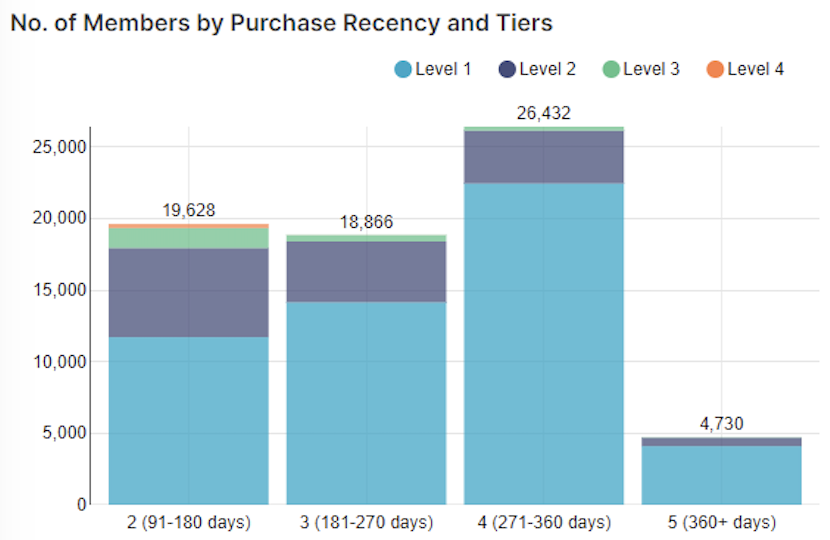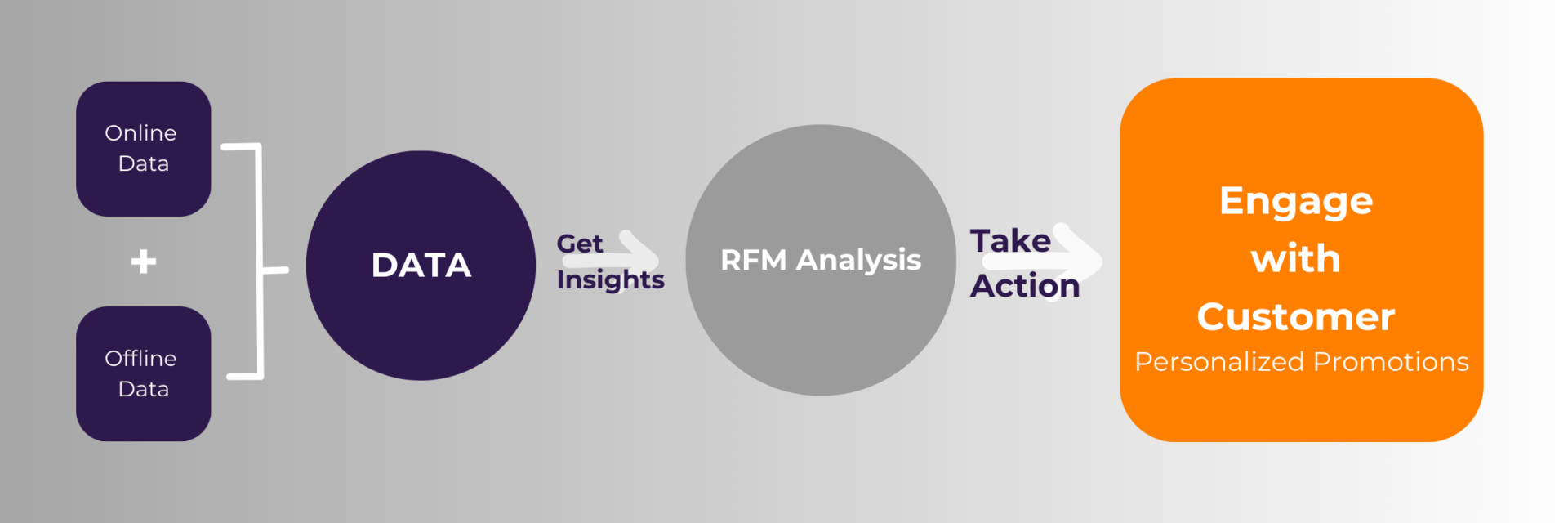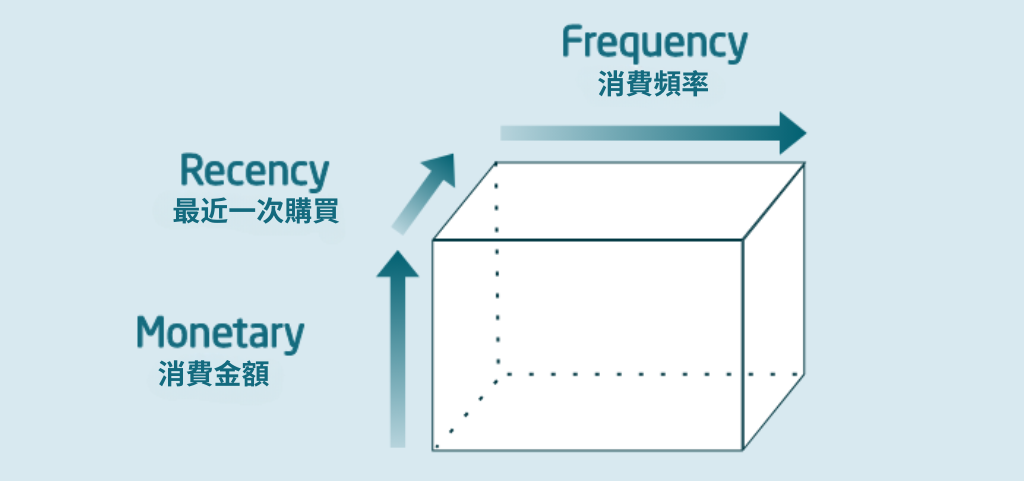Quantify Customer Activity Using the RFM Model to Identify the True Value of Customers
In the previous article, we shared with you the importance of repeat and loyal customers to a business. Your brand’s database may already contain a certain amount of transaction records and customer information, but you might not know how to quantitatively utilize this information to maximize the value of the data: Who are the most valuable customers? How can I segment them for targeted promotions? Which customers should I offer discounts to?
After establishing the brand database, using data analysis to assist in business decision-making can help us better utilize the collected data. The RFM model is a practical analysis tool that businesses can refer to for analyzing customer consumption patterns for segmentation. You may then design promotional strategies based on the characteristics of the customer groups within different segments to attract their continued purchases and establish customer retention strategies.
Introduction to the RFM Model: What is RFM?
The RFM model is actually composed of the initials of three data indicators: Recency, Frequency, and Monetary. It is used to describe the current value status of customers.
Recency (Time since the last purchase)
Recency is used to determine the activity level of customers. The shorter the time interval, the more active the relationship between the customer and the brand is, and the more likely they are to make another purchase.
Frequency (Purchase frequency)
Frequency is used to calculate the number of purchases a customer has made within a specific time period. The more purchases they make, the more satisfied they are with the brand or the higher their loyalty to the brand.
Monetary (Total spending)
Monetary refers to the total amount of money a customer has spent within a specific time period. The higher the spending amount, the higher the customer’s recognition of the brand or product, and the higher their customer value.
RFM Model Demonstration
We need to find the information for each customer in the RFM indicators within the customer database, such as:

After preparing the data range, divide the customers into quartiles based on their performance in each of the three indicators. For example, for the Recency indicator, the top 25% of customers in terms of spending will receive a recency score of 1; the bottom 25% of customers will receive a score of 4. Similarly, calculate the scores for the other two indicators.

We will obtain a three-digit RFM score for each customer, resulting in up to 64 different RFM score combinations. Therefore, businesses need to group customers with similar compositions according to their needs.

From this, we can decide which customers to develop or retain based on these three characteristics. For example, customers who score well in all three indicators are the most important and valuable partners for the business; customers who perform well in purchase frequency and spending amount but have not made a recent purchase are the ones the business most needs to find ways to retain.
By using the three indicators in the RFM model, brands can clearly identify the current status of customers and adjust their interaction strategies based on the latest customer status. Whether it is retention, increasing purchase amounts, attracting repeat purchases, or increasing purchase frequency, targeted personalized marketing can be carried out.
The Importance of Data Integration
If data is dispersed across various systems and in different formats, requiring data cleansing and formatting adjustments each time it is used, the analysis work becomes cumbersome and inefficient. Unified data integration can also bring the following benefits to the brand:
Improving Data Quality
Data integration can significantly improve data quality, reducing the workload of data cleansing and verification. Integrating data from different sources can eliminate duplicates and inconsistencies, ensuring data completeness and accuracy. For example, in a customer database, integration can prevent the interruption of interaction journeys caused by the same customer’s orders being scattered across more than one customer profile.
Simplifying Data Management Processes
Integrating data can simplify data management processes, making data easier to access and analyze. Centralizing all data on the same platform facilitates data retrieval and analysis, greatly reducing the time and labor costs in the data preparation phase.
Enhancing Data Quality and Brand Analysis Capabilities
Data integration helps enhance a brand’s data analysis capabilities, thereby assisting the brand in making more data-driven strategies. Integrating multi-dimensional data allows for more in-depth data analysis, uncovering potential market trends. For instance, by using the RFM model, which requires analyzing three customer data indicators together, brands can identify customer groups that need retention early on.
Read More: Stop Guessing Preferences: Data-Driven Marketing
Case Study: Analyzing Data Using a Loyalty Membership System
By utilizing a loyalty program with its operational systems, a home goods retail brand combines customer profiles and sales records for analysis. The purchase records of the same customer will be displayed in one single customer profile, making it easy to analyze changes in the same member’s status and identify the customer groups that currently need retention actions.
Analyzing Member Consumption Habits from Existing Purchase Data
By establishing a unified member profile across systems, brands can manage and analyze more easily. They can identify any changes in customer purchase frequency, thereby avoiding customer journey interruptions caused by dispersed member profiles. Not only can they view the most recent purchase time (Recency) and track purchase frequency (Frequency), but they can also compare the intervals between each shopping date to distinguish the activity status of the same member. Additionally, they can compare the shopping frequency across different membership tiers.

Understanding Market Changes from Consumption Variations
With integrated member profiles, brands can identify changes in customer activity status, such as sudden increases or decreases in the frequency of purchase records. For brands, this is important information for observing and understanding customer behavior. This information helps brands capture market trends or anticipate shifts in member preferences, enabling the development of more precise market strategies and enhancing the brand’s market responsiveness.
Timely Interaction Strategies Based on Consumption Changes
The brand not only uses this data to understand trends but also engages in targeted interactions with members whose activity status has changed. For instance, they can reclassify members with decreased shopping frequency into the same segmentation and send retention messages with repurchase offers to this segmentation group, reestablishing connections with customers and achieving effective retention.
Achieving the Ultimate Goal with Data: Enhancing Brand Performance
After collecting and integrating data, and using analytical tools like RFM metrics to gain valuable insights, all previous efforts would be wasted if these insights are not fully utilized. The true purpose of the brand is to use the customer insights derived from this data to take action and make targeted business decisions.
Collecting data and analyzing insights is the prelude to subsequent actions. Data analysis allows brands to identify the current target audience, guide decisions and marketing strategies based on results, and engage with the target audience in ways that meet their needs. Finding the right interaction targets and suitable interaction methods, whether the goal is to increase conversion rates, promote repurchases, or enhance brand loyalty, can make strategies more effective.
Connecting data insights with business decisions completes the entire customer interaction cycle, ultimately enhancing the brand’s overall performance. When a brand can effectively transform data insights into actions, it not only increases conversion rates and repurchase rates but also boosts customer satisfaction and loyalty, achieving long-term business success.
To sum up, data analysis is just the beginning; the real value lies in how these insights are used to make decisions and take actions. This not only allows the brand to stand out in the competition but also builds closer and more lasting relationships with customers.

Let the Motherapp Membership Loyalty Platform be an effective tool for understanding your customers. By seamlessly integrating and connecting the membership interaction system, sales data, and CRM analysis dashboard, it automatically synchronizes dispersed system data and presents analysis results from a graphical perspective. This helps your brand collect, analyze, and utilize the latest customer information, enabling precise remarketing through the membership system, and starting from today, cultivating repeat customers.
A User-Friendly CRM for Marketers: Master Your Loyalty Program
To learn more about how to use our user-friendly CRM designed for marketers to master your loyalty program, visit the Motherapp Loyalty Solution CRM Solutions page to discover more. Experience the powerful capabilities of personalized loyalty activities and data-driven insights!
Contact us now for more professional advice and one-on-one consultation.
Keep up with us – follow us on social media!

